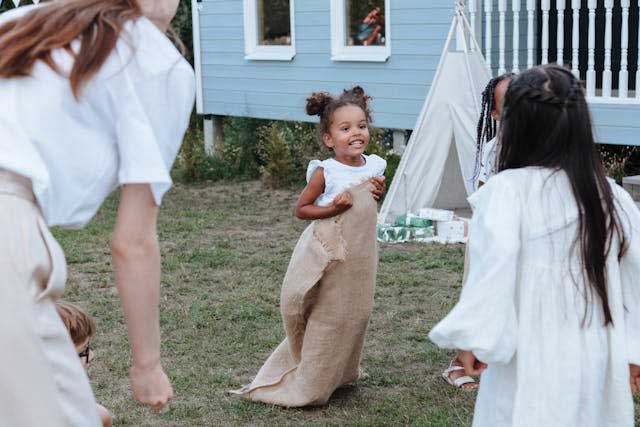
In today’s digital age, it’s easy for kids to get caught up in screen time and forget the joys of playing outside. However, outdoor play is not just a pastime, it’s a crucial element for their physical, mental, and emotional well-being.
Research shows that spending time outside improves physical health, enhances mental clarity and focus, boosts emotional intelligence and happiness, develops social skills and friendships, and increases creativity and imagination.
Spending time outside helps children develop gross motor skills, improve their focus, and become more calm and happy.
We have compiled a list here in this article. Five ways to encourage outdoor play are:
Lead By Example – Do You Get Some Time Off The Screen Yourself?
Remember, kids mimic your behaviour, so grab a shovel, plant flowers or vegetables, or kick a ball around.
Show your child that outdoor play is not just fun, but also valuable.
Leading by example is a powerful way to engage your child in outdoor play.
Children often mimic their parent’s behaviour, so you must model the habits you want them to adopt. For example, here are some ways to lead by example:
- Demonstrate enthusiasm for outdoor activities. Show your child that you enjoy spending time outside by expressing excitement and enthusiasm for outdoor activities.
- Share your own outdoor experiences. Tell your child about your favourite childhood outdoor activities or share stories of your outdoor adventures.
- Participate alongside them. Join your child in outdoor play, whether it’s playing catch, going for a hike, or simply exploring the backyard.
- Make outdoor activities a family affair. Involve your child in planning and preparing for outdoor activities like picnics or camping trips. This not only makes them feel included but also strengthens the family bond.
- Showcase the benefits of outdoor play. Explain to your child how outdoor play benefits physical and mental health, and demonstrate these benefits yourself.
Make The Backyard A Playground
You’d agree that transforming your backyard into a playground is an excellent way to encourage your child to spend more time outside.
Why does it matter, you may ask? A kid-friendly backyard boosts creativity and imagination, encourages physical activity and exercise, fosters social skills through outdoor play, and provides a safe space for exploration.
Consider adding play equipment such as swing sets, slides, climbing structures, and sandboxes to create an engaging outdoor space.
You can also incorporate games and challenges by creating an obstacle course using natural objects, setting up a scavenger hunt with hidden treasures, playing outdoor games like badminton or cornhole, and creating nature-themed challenges like identifying plants or animals.
Incorporate games and challenges by creating an obstacle course using natural objects, setting up a scavenger hunt with hidden treasures, playing outdoor games like badminton or cornhole, and creating nature-themed challenges like identifying plants or animals.
Schedule Outdoor Time
Scheduling outdoor time ensures your child prioritises nature and physical activity. Setting aside dedicated time daily, weekly, and seasonally creates consistency and makes outdoor activities a habit.
This helps balance screen time, improves physical and mental health, and enhances creativity.
Start by creating a family calendar or planner and involving your child in planning and goal-setting.
Allocate 30 minutes daily for outdoor activities like morning yoga, afternoon park visits, or evening stargazing.
Weekly schedules include nature walks, outdoor games, gardening, bike rides and scavenger hunts.
Seasonal events like planting flowers, outdoor Easter egg hunts, swimming, outdoor concerts, apple picking and leaf collecting add variety.
Be adaptable and adjust schedules as needed, ensuring engagement and flexibility. Combining outdoor time with educational activities makes learning fun.
Scheduling outdoor time offers numerous benefits, including increased physical activity, improved mental clarity, enhanced creativity, better social skills and reduced screen time.
By prioritising nature, you foster a lifelong connection between your child and the outdoors.
Make outdoor time non-negotiable and a family affair to create lasting memories and promote overall well-being.
Find Out Their Outdoor Passion
Exposure is key. Introduce your kid to activities like sports, gardening, photography, and nature scavenger hunts.
Then Make It Fun
Create outdoor games and challenges, such as sack races, egg and spoon races, hide-and-seek, scavenger hunts, and water games.
Above all, limit screen time and set boundaries for the kids. Invite friends over for playdates and encourage exploration. Make outdoor play a family affair to spend quality time together.
Also Read: 5 important Roles Your Husband Should Play In Your Home
Tailor outdoor activities to your child’s age. For toddlers (1-3), focus on sensory exploration and playgrounds. In the case of preschoolers (3-5), try outdoor games and nature walks.
For school-age children (6-12), engage in sports, gardening, and outdoor adventures.
In addition, don’t let weather, safety concerns, or lack of interest stop you.
Try indoor gardening or indoor obstacle games on rainy days.
Create a safe outdoor space and find activities that spark your child’s passion.
Therefore, in conclusion, getting your kid to play outside isn’t rocket science, but it requires creativity, consistency, and a willingness to get messy.
These five simple steps will raise a happy, healthy, and adventurous child.
Find more resources on parenting here.



